Albatrosses and other seabirds
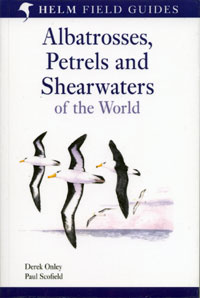
Albatrosses, Petrels and Shearwaters of the World (Helm Field Guides)

by Derek Onley, Paul Schofield
Publishing scheduled for end of March 2007
Published by: A&C Black
ISBN 9780713643329. Paperback, 224 pages. Illustrations: 46 colour plates (by Derek Onley), distribution maps for every species.
A practical new guide which describes the 136 species of storm petrels of the whole world. The illustrations were drawn by Derek Onley, who also collaborated on the seabird guide described below.

Identification of Seabirds of the Southern Ocean - A Guide for Scientific Observers Aboard Fishing Vessels

Derek Onley & Sandy Bartle
Published by Te Papa Press. 1999. Re-issued in 2006. ISBN-10: 0909010471
This thin hard cover guide (81 pages) was published in 1999 to assist researchers on board of fishing vessels in identifying living and dead Southern Ocean seabirds. The guide describes 36 of the most common species. The colour drawings are made by Derek Onley (who also worked on the 'Albatrosses, Petrels and Shearwaters of the World' and illustrated the 'Field Guide to New Zealand Birds').

Southern Albatrosses and Petrels - An Identification Guide (Helm Field Guides)

Harper, P. C. and F. C. Kinsky
Published by Victoria University Press, Australia 1978. ISBN ISBN 0-7055-0667-3. Soft-cover with plastic protective cover, 116 pages.
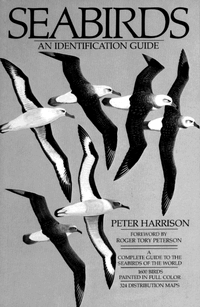
Seabirds - An Identification Guide

Peter Harrison
Published by Houghton Mifflin Company, Boston. ISBN 0-395-33253-2. First printing 1983, reprinted in 1985.
This handbook (448 pages) describes some 1600 seabirds from around the world. Peter Harrison did not only write the book, he also drew all the plates, which, by the way, I don't always find very clear. What is good are the variatons in plumage and sex in the drawings. The book also contains some 300 distribution maps.
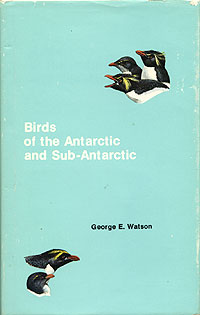
Birds of the Antarctic and Sub-Antarctic

George E. Watson (in collaboration with J. Phillip Angle & Peter C. Harper)
Published by the American Geophysical Union, 1st printing 1975. ISBN 0-87590-124-7.
Small hardcover handbook (350 pages), 11 colour plates, with additional line drawings. Throught the years better bird guides have been published about Antarctic and Subantarctic birds, but still this is a nice guide to browse every once in a while.
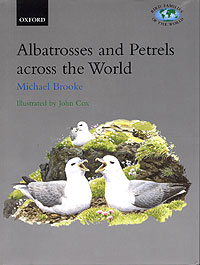
Albatrosses and Petrels across the World

Michael Brooke
Published by Oxford University Press. 1st edition, 2004, ISBN 0.19.850125.0
500 pages. The first half of this impressive book contains a general (breeding) biology of the albatrosses and petrels. The second half provides a detailed description of every bird individually with interesting details. As an example, access to the breeding burrow of the White-chinned petrel is often hidden under a pool of water (photograph shown). This book also contains 16 beautiful colour plates and a pleasant layout.
A more detailed review can be read online in marineornithology.org issue #33
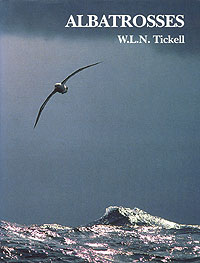
Albatrosses

W.L.N. Tickell
Published by Pica Press, Sussex UK. 1st edition, 2000, ISBN 1.873403.94.1
448 pages. At a first glimpse, Albatrosses looks like yet another hefty book on these seabirds, but it contains an surprising amount of information with little overlap with similar scientific books that I have reviewed here. The first chapters are dedicated to the albatrosses (grouped as Southern Albatrosses, Tropical Albatrosses and Northern Albatrosses), with a lot of historial data on the islands where the albatrosses have their colonies and the role of man. The next section (Comparative biology) discusses flight techniques, behaviour and ecology. In the last section (Victims and verse) Lance Tickell comments on the relation man has had toward albatrosses, and he quotes some of the poets that have been written about these birds. The book finishes off with a number of highly detailed and interesting apendices, such as the one on total number of breeding pairs and the one detailing prey species. A couple of pages finally show photographs of each of the albatross species. This book is a must for anyone who wishes to learn more about albatrosses.
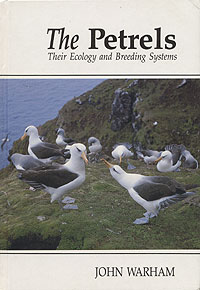
The Petrels: Their Ecology and Breeding Systems

John Warham
Publisher: Academic Press, USA. 1st print, 1990, ISBN 0.12.735420.4
440 pages. This is the first of the two standard works on tubenoses written by New Zealander John Warham. This first volume consists of fifteen chapters, of which roughly twothirds (chapters 2-10) are dedicated to the description of the different seabird families focussing on physiology, behaviour, taxonomy, distribution, migration, etc. The style is very factual (scientific) and detailed, but every page offers interesting details. In fact, the author answers many questions I had not even asked myself.
The remaining chapters (11-15) cover the breeding biology. All other aspects are described in the second volume (described below).
The books just contain functional illustrations, no colour photos to liven up the appearance. The solid cover and format make these books practical to hand. Unfortunately these great books for anyone interested in albatrosses and petrels are sold out, so you'll have to try to find them through (on-line) second-hand bookstores.
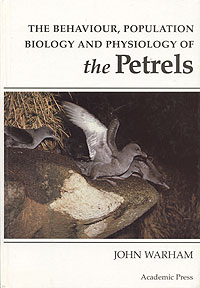
The behaviour, Population Biology and Physiology of the Petrels

John Warham
Publisher: Academic Press, USA. 1st edition, 1996, ISBN 0-12-735415-8
613 pagina's.
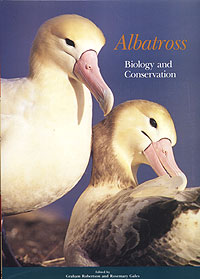
Albatrosses, Biology and Conservation
Edited by Graham Robertson and Rosemary Gales
Publisher: Chipping Norton, N.S.W., Surrey Beatty & Sons, 1998. ISBN: 0-949324-82-5
Hard cover, 312 pages. Published at the occasion of the Albatross Conference (1995), this book is a collection of scientific papers covering biology, ecology, population dynamics, conservation and taxonomy. There are many tables and graphs, and the odd colour photograph.
Tracking Ocean Wanderers

The global distribution of albatrosses and petrels. Results from the Global Procellariiform Trackign Workshop, 1-5 September 2003, Gordon's Bay, South Africa.
Frances Taylor, Janet Silk (compil.) & John Croxall (editor)
Published by BirdLife International, Cambridge, UK. 1st edition, 2004. ISBN 0.946888.55.8
100 pages. This A4-sized book interprets the scientific results of tagged albatrosses and their distribution. Birds from various colonies were tagged so as to identify their foraging waters. This report looks at the data from different angels: distribution variation between male-female, old-young bird, distribution variation depending on breeding stage, between similar species from distinct colonies, and the areas themselves. The purpose of all this is to collect data which should prevent that albatrosses drown on longline fishing hooks. Between all the facts there are interesting details to be discovered. No need to say this report contains many distribution maps.
The report is not commercially available, but it is available for download from BirdLife's website, both the complete report (PDF, 4.9 MB) and the executive summary (PDF, 125 KB).

Albatrosses
Terry Lindsay
Collingwood: CSIRO Publishing, 2008. ISBN: 0643094210 (EAN: 9780643094215)
Paperback, 139 pages, with colour photographs and illustrations.
This book is not so much about identification of albatrossen, but covers their biology and conservation.
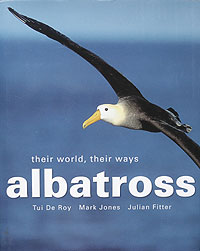
Albatross: their world, their ways
Tui De Roy, Mark Jones and Julian Fitter
Collingwood: CSIRO Publishing, 2008. ISBN: 0643095551 (EAN: 9780643095557)
Hardcover, 240 pages.
All 22 species of albatross are described in this book, which contains 300 beautiful photographs.
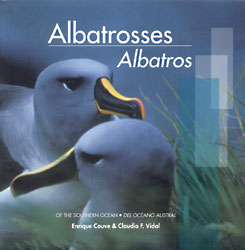
Albatrosses Of The Southern Ocean (Albatros del Océano Austral)

Enrique Couve, Claudio Vidal
Publisher: Editorial Fantástico Sur Birding Ltda, Chili 2005. ISBN 956-8007-10-5
Hardcover (~20x20 cm), 99 pages. Text in English Spanish
This booklet covers 12 albatross species, more a picture book than a true identification guide. Available through libraries in Ushuaia (Tierra del Fuego, Argentina).
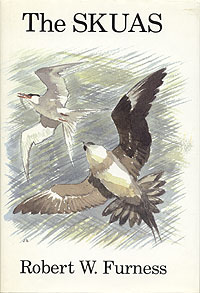
The Skuas

By Robert W. Furness
Publisher: T. & A. D. Poyser, Calton, 1987. Hardcover. ISBN 0.85661.046.1
363 pages. Small sized, compact typeset
This book covers all skuas, not just the ones from the southern hemisphere (being Brown Skua, South Polar Skua, Tristan Skua, Chilean Skua). There is a lot of information on skuas in general, but not specifically on the southern species, although the author does provide interesting details on the Tristan skuas on Gough, where he spent some time researching in the eighties. But there is relatively more information on skua populations on the (norhtern UK) Shetlands islands where the author has done a lot of research (mostly on Foula and Fair Isle).
This book, nice to handle and to read, provides also solid background information on behaviour, territory, kleptoparasitism and other feeding techniques, mating and breeding, but since it dates from 1987, I wonder if information on population sizes, distribution ranges and hybridization occurence are still reflecting today's situation. Still, it's worth a read. Skuas are impressive flyers, opportunists that deserve to be studied in more detail.
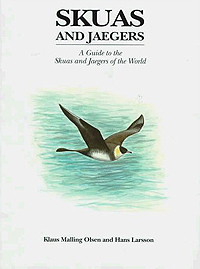
Skuas and Jaegers (A Guide to the Skuas and Jaegers of the World)
By Klaus Malling Olsen, Hans Larsson
Publisher: Yale University Press, 1997. Hardcover, 190 pages. ISBN 0300072694
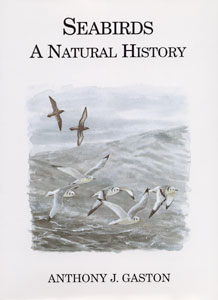
Seabirds: A Natural History

Anthony J. Gaston
Publisher: T & A D Poyser/A & C Black Publishers Ltd, 2004. ISBN 0-7136-6568-8
222 pages
This book covers seabirds in the broad meaning, including cormorants, divers and gulls, and its scope is global, covering all the world seas and not just the (sub)polair regions. In my opinion this causes the author to lose the thread - providing many personal stories, lists and examples, but missing a line of thought, a logic that I appreciate so much in Warham. There are many interesting facts about the life of seabirds (adaptions, breeding biology, evolution and distribution), but this book could have been more interesting if the author had focussed on his own area of research (murres). This book is simply too short to cover such an broad topic, so many topics are only briefly mentioned.
Includes index and bibliography.
Penguins
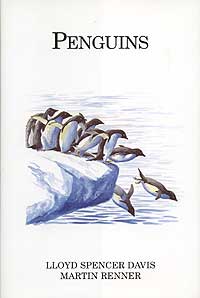
Penguins

Lloyd Spencer Davis & Martin Renner
Publisher: T & A D Poyser, 2003. ISBN 0.7136.6550
In 170 pages this book describes the scientific knowledge we have gathered about the various penguin species. Using all sorts of studies, books, papers, unpublished comments, the book, written in an accessible style, depicts the evolution of the species, which families exist today, how they breed and feed, select partners, raise chicks and how they moult, and finally, comments on today's conservation status. The publication never fails to point out that knowledge depends on the species, on the time and place, and on the researchers who interpreted the facts they were studying.
The recurrent theme throughout the book (and a penguin's life) is the key difference between inshore and offshore foraging penguin species, a difference which has great impact on the bird's physiology and survival strategies. Although this book has a scientific background, it is highly recommended, very informative and a pleasure to read for anyone interested in facts on the life of penguins.
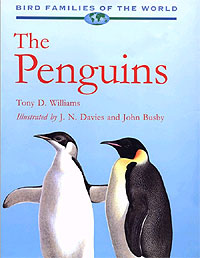
The Penguins

Series 'Bird Families Of The World'
Tony D. Williams
Publisher: Oxford University Press, 1995. ISBN: 019854667X. Hardcover. 352 pages, 8 colour plates, 40 drawings and 21 maps.
Thorough reference book from the same series as Albatrosses and Petrels across the World, described earlier on this page and with a similar setup: the first half of this book covers biology, ecology, and behaviour of penguins, as well as conservation issues. The second half covers each of the seventeen penguin species individually. Too bad this beautiful book is 'out of print'!
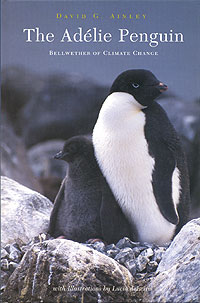
The Adélie Penguin - Bellwether of climate change

David G. Ainley
Publisher: Columbia University Press, 2002. ISBN: 0-231-12306-X. Hardcover. 310 pages.
This book sums up a lot of studies related to the Adélie Penguin. It explains the factors that determine colony size, there is extensive information on moulting for this species, and shows how crèche formation by older chicks coincides with the 'reoccupation' of nonbreeding birds that do not necessarily defend the chicks against skuas. More than anything else, it points out how Adélies depend on sea-ice to forage in an area not accessible to Chinstrap, Gentoo and other penguins. I would have loved to learn more about this species displays (what do their gestures and sounds mean), but there is little about this. Surprisingly, there is also nothing about the female's decision pattern to select a male, something which is covered in detail in Davis & Renner's study (see above) which was publised one year later. So is the Adélie a bellwether of climate change? The last chapter is dedicated to this topic, but not conclusive (then again: 'we don't know' is a conclusion in itself!).
The text covering these topics could have been more condensed in my opinion, sometimes I feel the author could have been more to the point. Facts are repeated throughout the book. This hardcover has a pleasant format and layout to read. The artistic pencil illustrations add no value and the copyright notice which accompanies each single illustration is redundant, even irritating. The black and white photographs in the middle section are not very useful either, but there are many graphs and tables that are worthwhile. There is an extensive literature list, but the index is short (e.g. 'hyperphagia' on p. 102 is not included).
See also the online review at marineornithology.org issue #34
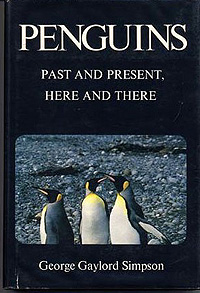
Penguins: Past and Present, Here and There

George Gaylord Simpson
New Haven and Londen, Yale University Press, 1976. ISBN: 0-300-01969-6
This is an interesting introduction into both extinct as extant penguins, although fossil penguins are mr G.G. Simpon's speciality. As such, the chapters that deal with fossil penguins, the discovery of the first penguin colonies by seafarers are the most interesting of this book. The remaining chapters are quite general and contain information that can be found in many other books. This 150-page study contains maps, illustrations and photographs both in colour and in black and white.
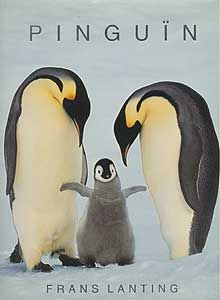
Penguin

Frans Lanting & Christine Eckstrom
Publisher: Taschen, 1999
Beautiful photographs as you would expect from Frans Lanting. The pictures were made from a human, esthetic point of view and do not pretend to provide you with biological background information. You do not learn a lot from this book, but it was never made for that purpose. See also www.lanting.com
Birds of South America
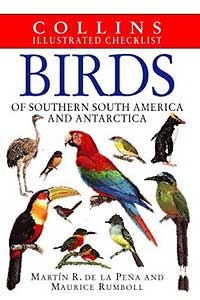
Collins Birds of Southern South America and Antarctica

Collins illustrated checklist
Martín R. de la Pena, Maurice Rumboll
Publisher: Harper Collins, 1998. ISBN 0002200775. Also published by Princeton under the title "Birds of Southern South America and Antarctica", ISBN 0.691.09035.1
Paperback, 304 pages.
A compact guide contains illustrations of about 1000 species. A short description of each bird, its behaviour and habitat. In the back of the book you will find a small map of the distribution for each bird. It can be hard to identify a bird just by the illustration in this book, the book Birds of Patagonia, Tierra del Fuego & Antarctic Peninsula (below) which contains photographs can be a welcome addition to the Collins guide. That is especially true for the birds in Southern South America and on the ocean (on Antarctica itself the birds are easier to identify).
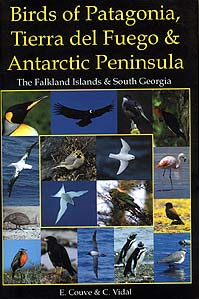
Birds of Patagonia, Tierra del Fuego & Antarctic Peninsula - The Falklands Islands & South Georgia

Aves de Patagonia, Tierra del Fuego y Península Antártica (Islas Malvinas y Georgia del Sur)
Enrique Couve, Claudio Vidal
Publisher: Editorial Fantástico Sur Birding Ltda, Chili 2003
Paperback, 656 pages. In English and Spanish.
Handbook containing a great many photographs of birds. Each bird is shown in some six photographs, not always great quality. This does give you a good idea of different postures and feathers. The description for each bird is both in English and Spanish and bird names are given in English, Argentinian, Chilean and Latin. Also contains distribution maps. Good book, but a little heavy to carry with you.